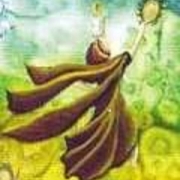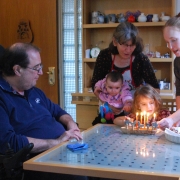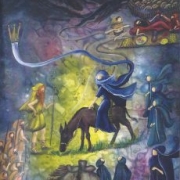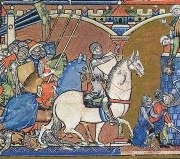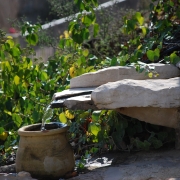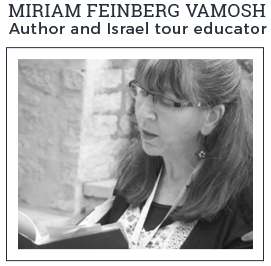Singing but Unsung – Ancient Women Musicians
Singing but Unsung – Ancient Women Musicians
A recent discovery at “Solomon’s Mines” in Timna reveals the first evidence of women at this harsh desert site. It’s an intriguing prelude to the tradition of women musicians in the Bible and enriches our thoughts about the women of the Bible who came later.
Archaeologists excavating the ancient copper mines in Timna in southern Israel were startled, according to the recent report in the Israeli newspaper Haaretz, to find the 3,200-year-old remains of a woman. Touchingly, the skeletal remains of her fetus were entombed with her.

Pottery figurine of a pregnant woman. Akhziv, seventh–sixth centuries BCE. Courtesy of Palphot.
Why were the the experts startled? Archaeologist Erez Bar-Yosef of Tel Aviv University, digging at the site, explained to Haaretz that because Timna was not home, but rather a work site, prominent people who died there might be temporarily buried and eventually taken home for permanent interment. Slaves were accorded no real burial at all, Bar-Yosef said. Hence, most tombs they find are empty. But even when human remains were found, none were of women. Thus, this woman must have been someone special. She was important enough to be buried with jewelry – two beautiful, Egyptian-style glass beads were found – and what’s more, her final resting place was just 200 meters from the famous temple of Hathor, at the base of the massive cliffs known as Solomon’s Pillars.

Egyptian woman playing an instrument. From a fourteenth century BCE.
Tel Aviv University Egyptologist Deborah Sweeney told Haaretz that this apparently highly regarded woman may have been a singer or musician for Hathor, the Egyptian goddess of love, fertility, music and mines, whose image was incised millennia ago into the red rock of Solomon’s Pillars, high above the temple.
Women and music have been associated for ages in this part of the world, as attested by ancient figurines and plaques. Nine sistra (musical rattles associated with the worship of Hathor) were found at Timna itself by its first excavator, Beno Rothenberg.

Reconstruction of a banquet scene, showing women musicians, common in Egyptian tomb decorations of aristocrats in the New Kingdom (1570–1070). Courtesy of Palphot.
Women in the Old Testament in Song and Dance
The dramatic discovery at Timna is a good opportunity to recall the female Bible characters who sang and danced in praise of God. While the role of women in the Bible seems often to have been limited to family and home, it was in song and dance that they could give full expression to their creativity and devotion to God in the public sphere. Perhaps the most famous songstress in the Bible – and one of its best-known women of faith – is Miriam, who led the women in song and dance by the Red Sea – “Sing to the Lord, for he is highly exalted…”(Exod. 15:20–21).

Biblical Miriam dancing and playing the tamborine, by contemporary artist Rikki Rothenberg. Courtesy of Rikki Rothenberg.
“A New Psalm”
Deborah – one of the strong women of the Bible, sang a song of victory in battle in Judges 5. Later, Solomon says he had both men and women singers at his court (Eccl. 2:8). Also in Ecclesiastes (12:3–5) are references to slowing down in old age, one of which relates to women singers. “The daughters of music are brought down low.” The Apocrypha contains a magnificent praise poem by another of the strong women of the Bible, Judith: “Begin unto my God with timbrels, sing unto my Lord with cymbals: tune unto him a new psalm.”
And moving on to women of the New Testament, while according to Luke (1:46–55), Mary spoke the Magnificat, the text itself appears in poetic style, and it became one of the earliest hymns, dating back to the beginning of Christianity.
Who was the “pregnant woman of Timna”? We hope the archaeologists will be able to tell us more in the future. She must have been a strong woman to have traveled so far and endured the rigors of the unforgiving desert. This woman lived on the cusp of Bible times, and in the southern reaches of the Bible lands. And so we can call upon her to help us remember with love and admiration a long line of strong women of the Bible, who sing out to us to this very day.

In addition to her series on daily life in Bible days, Miriam Feinberg Vamosh is the author of The Scroll, a historical novel about a woman of Masada and her descendants over three generations, who faced the challenges we still face today.
For further reading:
“Archaeologists startled to find remains of pregnant woman buried in ‘King Solomon’s Mines,’ by Ariel David. Oct. 31, 2017. https://www.haaretz.com/archaeology/1.820180.
“A Joyful Noise: Music and Dance, in Women at the Time of the Bible, by Miriam Feinberg Vamosh (Palphot).

